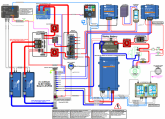So I've been pondering inverter circuit protection lately, and thinking about how the conventional wisdom of circuit protection doesn't necessarily apply to an inverter.
While it is as important as ever to size your fuse to protect the wire, it may also be practical and advisable to size your fuse to protect the device. In the case of an inverter, the conventional rule of thumb that 'a fuse should be roughly 1.25x the max amperage of a device' needs to be... wait for it... inverted (sorry I couldn't help myself

). Point being, maybe the fuse on an inverter circuit should be <100% of the inverter rating, so your breaker will trip before the inverter is harmed.
With typical loads, you want to ensure your fuse won't blow everytime your device is pulling max amps, so a little breathing room makes sense, so you size the fuse a bit bigger than the load. But an inverter isn't a traditional load, its just passing along power to the AC loads.The implications of this are twofold:
- There is no reason an inverter ever needs to pull its rated output
- It can and will exceed its rated output--to its detriment--if an AC load exceeds your inverters rating, the inverter will try to deliver, even if it damages itself in the process.
For this reason, I'm thinking an inverter should be treated more like a wire than a load. I.E. make sure the fuse blows before the capacity of the inverter is exceeded so that an improperly sized load on the AC side doesn't damage your inverter or pose a safety risk.
It may be ideal to have two separate protection devices in the circuit, one at the beginning of the circuit to protect the wire and sized using the traditional method, the second (resettable breaker) at the inverter sized to trip before the inverter exceeds its max load. See below:

If my explanation wasn't clear
this video is what got me thinking about the idea, and might do a better job explaining than I can.
I'm curious to hear everyone's thoughts.






